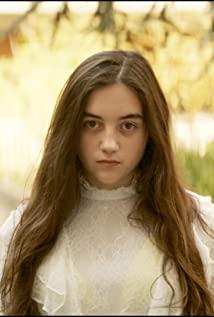words written in front
That's a forbidden romance. I clearly saw the love and lust floating in the air, filling the room, spreading with the smell of paint and canvas, but at the same time being suppressed by an inexplicable sadness, like that in the sun Dust, in the warm halo, is clear and hazy.
In 120 minutes, the entire film is slowly burning. The fire did not have the momentum of raging in an instant, but was brewing leisurely in the dark, taking care of itself.
Director Celine Sciamma is behind this, slowly adding firewood, quietly watching the story burn. She doesn't let a bit of sparks slip away, but makes every frame so exquisite that you want to frame them in the most gorgeous frame, but you might disturb their quiet and harmonious beauty.
It reminded me of "Girl with a Pearl Earring", of the stud that pierced the earlobe.
Through the screen, watching those brave, independent women, immersed in music and poetry, you can hear the sound of dry wood peeling behind the flames.
Lois: "While you're looking at the people in the painting, who am I looking at?"
Portrait of a Burning Woman / Portrait of a Burning Woman.
PS The interpretation of the title of the film below is just my thoughts on the Chinese translation. This interpretation may not hold for French titles. If a friend who learns French finds my mistake, I sincerely hope you can point it out for me.
There are two ways to read the Chinese name of the film. Before watching the movie, I also couldn't remember it accurately for a while. But after thinking about it carefully, there may be some deep meaning behind this.
One is "Portrait of a Lady on Fire". In this reading, "burning" is used as an adjective to describe the state of the woman in the painting, meaning that the depicted object is burning at that particular moment of freeze.
The other is "Portrait of a Burning Woman". This reading treats "burning" as an action. What it shows is the act of burning the portrait of a woman with fire.
These two readings contain three different meanings.
At the beginning of the film, the painter Mary guides the students to create in the studio and acts as a model for the students. At this time, she accidentally saw a student move out a painting that she had kept for a long time - "Portrait of a Burning Woman". It was this painting that brought Mary and the audience into her memories, towards her unforgettable past and love.
This is also the first layer of the film's title, referring to the portrait that Mary created for her lover Lois at the bonfire. The so-called "burning woman" refers to Lois. At the bonfire party, she accidentally let the fire burn her skirt because she looked at Mary in the opposite night.
Mary was entrusted by Lois' mother to paint a portrait of Lois, who was about to get married. Lois, however, resisted his parents' orders with his actions. She refused to model for the painter, which brought many difficulties to Mary's creation. When Mary finally relied on her own secret observation to complete the painting and proudly showed it to Lois, Lois criticized Mary in a bad mood.
"But it wasn't alive, I couldn't feel the life force," she said .
Behind this lies the second meaning of "Burning Woman", which is the flame in Lois' chest and a force against this world. Although the man who married Lois in Milan, the painters of various colors, or the mother all wanted to freeze Lois in a painting, use a frame to imprison her freedom, and use layers of paint to seal her desires Break free of restless heart. But she still couldn't be quiet.
At this moment, she seems to be frozen, but there is an undercurrent in her heart, glowing with infinite vitality. There was a frenzy that flourished in her heart. Maybe one day, the flames of this power will spread, no longer bound by the body, and burn the frame, or even the entire portrait.
The so-called burning portrait is actually breaking the stereotypes and rules of women in the society at that time. This is the third meaning behind the title, chanting Celine Sciamma's good wishes.
When I was talking about "In the Mood for Love", I talked about the door frame composition used by Wong Kar-wai and the meaning of the tight cheongsam that those women wore. They are like social dogmas and moral constraints that confine people to specific spaces. Here, the frames, and the waistbands that suffocate the women's intricate attire.
Burning portraits is the desire to break through this limited space.
Painting is not like photography, it is impossible to accurately capture the model's frown and smile in an instant. What finally appears on the screen is actually the condensed collection of all observations made by the artist over a period of time. In such an era when most of the painters were men, the women in the oil paintings became the fixed frame of the female image in the eyes of men.
This is also the biggest reason for Lois' dissatisfaction with Mary's first work.
At this moment, Mary and Lois have not yet determined each other's intentions. Like many painters in the past, she does not have the slightest emotion, but only regards Lois as a statue, as a flat object to describe. Just like the man who wanted to marry Lois completely ignored Lois's feelings in this marriage, she created her own words. What Loyce longs for is the flow of emotion, equality, sharing a dynamic moment with the painter or with a future partner, not at the mercy and choice of others.
As she asked Mary: "While you are looking at the people in the painting, who am I looking at?"
Lois: "Does freedom mean loneliness?"
Vivaldi's Violin Concerto "The Four Seasons" "Summer"
This "Summer" by Vivaldi appears twice in the film. It's also one of my favorites in the "Four Seasons" set. In the fast-paced performance of the violin, I felt the sultry heat, restlessness, and unease of summer. Like the deep bond between Mary and Lois, passionate and restrained.
In order to help the audience understand the emotions he wanted to express, Vivaldi wrote a sonnet on the title page of the score, and used words to further describe the picture shown in the music. The gist of the poem is this:
hot summer,
the herd is sleepy,
The pine forest is on fire.
Turtledoves and canaries sang.
A fresh breeze blows,
In an instant, the north wind blew strongly.
The shepherd was terrified,
Weep for the doom that fell from the sky.
The drowsy sick body tosses and turns sleepless,
More afraid of the lightning and thunder,
The herd is also plagued by flies.
what! His fears are just beginning:
downpours of hail,
destroyed his crops.
(Data sourced from Baidu)
It was the confrontation between the blowing cold wind and the scorching heat before the storm came.
In "Portrait of a Burning Woman", this cold is a cage, a picture frame, a villa on a desert island, and rough waves. The heat is the urge to struggle, the vast sea, the galloping against the wind, the sprinting to embrace the waves.
It is a balance between reason and emotion, a competition between ethics and love, a competition between dogmatic constraints and free will.
The first appearance of "Summer" in the film is in a closed and private space - Mary's room.
There were only Mary and Lois in this space, and they were huddled together on the narrow piano bench. While recalling and beating the melody of "Summer" on the keys, Marie told Lois the story behind the music and painted the picture in Vivaldi's mind. In the intermittent sound of the piano, Mary secretly confided her unease and fear, as well as her dissatisfaction with all external constraints.
At this moment, Mary may have been in love with Lois, but I can't judge exactly. But I know she seems to be suppressing something. Their bodies were so close together, yet they were still far apart.
Whether there is a difference between the superior and the inferior, or to conceal their affection, the distance between them at this moment is the panic of Mary. It was she herself who introduced thousands of pairs of eyes into this space where only the two of them were, because she always kept in mind the sharp eyes of the world, and proceeded cautiously under this kind of gaze.
The second time the piece appeared, it was in an open theater, in front of a large audience.
It was the end of the film, and Lois was married and had children. This time, what was in front of her was no longer a fragmented monophony, but a complete and grand piece of music, which seemed to condense all the power of the lover she missed. This time, no one will explain it for her. It was replaced by surging memories, and all the unwillingness.
Lois was there, staring intently at the stage, weeping, while Mary sat at the far end of the theater, looking at her in the distance. The two are separated by a vast theater, separated by thousands of audiences, separated by a society and the whole world. This kind of distance is all reality, the reason why they can't stay together, and the picture frame they have always longed to burn.
At this moment, although they are far apart, they are warm next to each other in another high place, looking down on all obstacles together, confronting the whole world with the unquenchable enthusiasm in their chests and the memory of those short two weeks.
Mary: "It's just a flash in the pan. A portrait that pursues vitality will lose its true essence due to the passage of time." Lois: "Not everything in the world is so short-lived, such as a deep love that comes from the heart."
Mary and Lois
Mary is the male figure in this forbidden relationship. As a painter, she was doing work that was dominated by men in the society at that time. She has been to Milan, her movements are unrestricted, she has experienced the taste of love, and she seems to be free. But in fact, before she fell in love with Lois, she was stuck in an invisible cage.
She is rational, repressed, has strong self-esteem, and is very concerned about the opinions of others , so she destroys her own paintings under the "provocation" of Lois. She was not without anger at all the injustices against women in society at the time. It's just that compared to Lois, this anger is quiet, concealed, and carried on quietly. So when the public prevents female painters from painting male nudes and creating great works, she can only paint in private.
Of course, her status also determined that she couldn't resist as willfully and blatantly like Lois. For a female painter like her who relies on painting for a living, it is only by concealing her edge in time that she can get caught in the industry.
Her relationship with Lois reminds me of the struggling Ennis and the true love Jack in Brokeback Mountain. In middle age, Ennis shouted to Jack, who was already rich, "You forget what it feels like to be poor."
The scenery of Brokeback Mountain has not changed, but the difference in material conditions makes them different at last.
Mary went ashore from the sea and entered the house; Lois left the house and ran to the sea.
On the surface, Lois was watched by his mother, restrained by fate, imprisoned, controlled, and seemed to be trapped in a cage. But she is really a trapped beast, full of ambition and untamed power.
She is unrestrained, longing for freedom, daring to fight, more enthusiastic and more courageous than Mary outside the cage.
Lois would not bow his head to the arrogant painter. No matter if you are male or female, former painters or Mary, as long as you treat her as a weakling who cannot control her own destiny, a lamb to be slaughtered, a woman to be married, or a soulless death that is no different from plaster No matter how hard you try, you can't make her smile even in front of you, this arrogant idiot. This is Lois' attitude.
When Mary interprets "Summer" to Lois, she first touches the keys carefully through the cover cloth on the piano. It was Lois who went to the piano and lifted the cloth covering the piano for her, so that she could actually touch the keyboard.
When the maid went to have an abortion without telling the hostess, Mary's attitude was to choose not to look down, and it was Lois who taught her to face it, and even encouraged her to record this touching scene with a paintbrush. Women yearn for the right to choose abortion and the right to control their own bodies without regard for the opinions of others, which at the same time symbolizes the pursuit of equality and higher social status.
Perhaps it is in these places that Celine Sciamma tells us, with a silent tenderness and fortitude, that in their short-lived relationship in the future, Mary will grow under the influence of Lois, letting go of her all these years. He absorbed the magnanimity and bravery of Lois, and finally was able to convey his voice to the world.
The lovers who are destined to be unable to stay together are about to face separation. The two lean on the bed and talk to each other about their feelings. Lois hopes that Mary will paint her at this time so that she can miss it in the future.
Mary left the painting on page 28 of the book.
So the page number "28" has become a tacit secret of the two.
To see herself, Mary put a mirror on Lois. This is a mirror placed in the private part, but it does not make the whole picture full of eroticism. On the contrary, it makes me feel that everything is so bright, magnanimous, and even contains a kind of hope.
For Mary, who has always been discreet and apprehensive, it was liberating.
The mirror placed in her private parts illuminated her face, symbolizing the first time she bravely faced up to her own secrets, accepted everything about herself, and stopped covering up. At this moment, although she is about to leave Lois, she has completed her growth. So after that, when asked by the old man in the gallery, she was able to bravely admit that the painting about Orpheus was actually her own.
Lois: "Go back."
The maid, Mary, and Lois sat around the table, reading the Greek myths of Orpheus and Eurydice together. The seemingly distant fairy tale also clearly foreshadows the final outcome of the two.
In mythology, Orpheus, the son of the sun god Apollo, went to hell to save his wife who was bitten by a snake. Hades warned him not to look back when he left Hades. Orpheus agreed, but at that moment, unable to restrain his thoughts, he looked back at his wife.
Such a story seems like fate, like a curse. Pluto's request seems simple, just like the discussion of the three women in the film, Orpheus only needs to hold back, and he can stay with his wife when he arrives in the Yang Realm, why did he turn his head.
In fact, if it was so easy to do, Pluto would not be so tested.
For Orpheus's turn back, I'm leaning towards Mary and the Maid's explanation, maybe just because Eurydice called him, it's that simple. Just as when parting, Mary hurriedly hugged Lois and rushed down the stairs, thinking she could quickly escape from this place. Klois chased after him and stopped Mary.
"Go back."
At this call, Mary turned her head without thinking. Perhaps it is precisely because of this turning back, without a moment's hesitation, that in the future, the two of them, despite being separated from each other, still insist on being themselves and fight non-stop.
Twice Mary saw Lois in her wedding dress, standing at the end of the corridor. It was her nightmare, the fear she couldn't let go of deep inside. She clearly knew that Lois could not escape her fate after all, but she would use her paintings to send Lois into the arms of others with her own hands.
In Mary's hallucinations, Lois is always in the dark. As Lois said, Mary thought she was submissive and did not dare to resist. It was not until the last moment when Lois stood on the stairs and stopped Mary in her wedding dress that she was illuminated by the bright sunlight.
It was sunlight coming in from outside the house, through the crack of the door. It is derived from that turning back of Mary.
If Mary hadn't looked back, neither she nor we would have been able to see the "burning" woman illuminated by the light. This light told Marie that even if Lois married Milan, she would not stop resisting. And Mary's return also means that no matter where she goes in the future, she will listen to her inner voice.
Their farewells were simple and short, without too many words or tears.
Everything is in that look back.
Just like the comment from the old gentleman in the gallery.
Perhaps throughout the ages, too many people have deliberately magnified the mourning and sorrow of Orpheus and Eurydice.
As for themselves, it's just saying goodbye.
View more about Portrait of a Lady on Fire reviews











